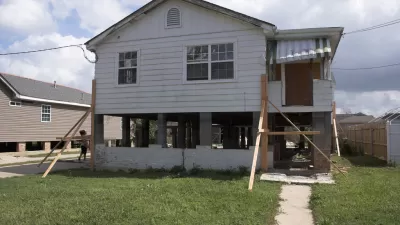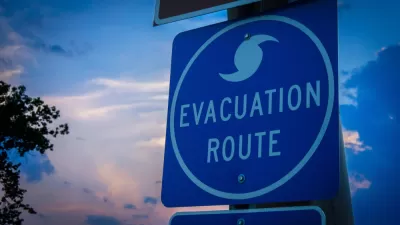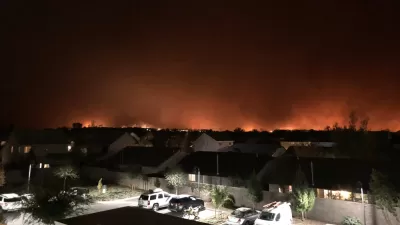In her new book, A Paradise Built in Hell: The Extraordinary Communities That Arise in Disaster, journalist and essayist Rebecca Solnit describes a phenomenon that is rarely mentioned in the context of disaster preparedness: the spirit of caring -- even joy -- that can emerge in the face of calamity.
In her new book, A Paradise Built in Hell: The Extraordinary Communities That Arise in Disaster, journalist and essayist Rebecca Solnit describes a phenomenon that is rarely mentioned in the context of disaster preparedness: the spirit of caring -- even joy -- that can emerge in the face of calamity.
In case after case, she finds that catastrophes tend to generate "disaster utopias," in which people spontaneously come to the aid of their neighbors, social and class distinctions are erased, and exciting social possibilities for a more just society are revealed.
By contrast, Solnit finds the Hollywood version of disaster -- replete with widespread panic, looting and violence -- is almost nonexistent in the real world, and where it does occur it is owed to institutional failure and repressive overreaction on the part of governments.
The San Franciscan's earlier works include the gentrification exposé Hollow City: The Siege of San Francisco and the Crisis of American Urbanism. Here she takes the reader through a number of historically significant disasters over the past century. Through archival research, numerous interviews with survivors and frequent references to disaster sociologists, Solnit constructs an alternative and radical narrative of calamity.
For each disaster covered (the 1906 San Francisco earthquake; the 1917 Halifax explosion; the 1985 Mexico City earthquake; 9/11; and hurricane Katrina), Solnit explores a series of themes, which she then connects to other disasters, social theories and contemporary events.
As a writer on the progressive left, Solnit has created a "people's history" of urban destruction, which shows how extraordinary acts of empowerment and social capacity-building can emerge from disaster, and with them the erasure of the caustic distinctions of class and race.
Solnit tells of the legendary generosity following the Halifax explosion, and how the failure of the Mexican government to respond to the 1985 earthquake there led to a nationwide political awakening, which eventually broke the decades-long grip on power of the PRI(Institutional Revolution) party.
She also recounts the heroic actions taken by the passengers of Flight 93 on 9/11, and contrasts them painfully with then-president George W. Bush's initial non-response to the attacks, and the Air Force's inexplicable inability to prevent the strike on the Pentagon.
Such institutional failure is compounded, in Solnit's view, by the tendency of governments and other elites to panic when calamity strikes.
By expecting the worst from people, governments can turn disasters into catastrophes. In 1906, the army was unleashed on San Francisco with shoot-to-kill orders and an incoherent plan to contain fires – an action which led to perhaps hundreds of deaths and the incineration of much of the city. The other major example she offers is how, fearing panic following 9/11, the Bush Administration encouraged New Yorkers to return far too early to the horrifically toxic air in Lower Manhattan.
By far the most disturbing part of Solnit's book is her extensive and ground-breaking investigation into the aftermath of hurricane Katrina.
Amid wild, racist and unfounded media rumours of black gangs rampaging through the streets of New Orleans and the Superdome, whites armed themselves and began shooting black men on sight. Solnit documents dozens of such murders, about which officials have yet to take action.
Yet even in the poisonous ruins of New Orleans, Solnit still manages to find irrepressible joy as people rebuild their homes.
This recurring spirit of common purpose and generosity leads to her principal and troubling question: what is it about our everyday society that prevents such social possibilities from taking root permanently?
Solnit's book raises important questions for planners concerned with disaster preparedness. As our cities become more vulnerable to extreme weather and climate change, Solnit warns we will face successive and intensifying disasters. Unless we combine practical training for dealing with calamity with an official recognition of our tendency for mutual support and aid, rather than for violence and looting, the "elite panic" she describes will lead to ever more terrible consequences.

Alabama: Trump Terminates Settlements for Black Communities Harmed By Raw Sewage
Trump deemed the landmark civil rights agreement “illegal DEI and environmental justice policy.”

Planetizen Federal Action Tracker
A weekly monitor of how Trump’s orders and actions are impacting planners and planning in America.

The 120 Year Old Tiny Home Villages That Sheltered San Francisco’s Earthquake Refugees
More than a century ago, San Francisco mobilized to house thousands of residents displaced by the 1906 earthquake. Could their strategy offer a model for the present?

In Both Crashes and Crime, Public Transportation is Far Safer than Driving
Contrary to popular assumptions, public transportation has far lower crash and crime rates than automobile travel. For safer communities, improve and encourage transit travel.

Report: Zoning Reforms Should Complement Nashville’s Ambitious Transit Plan
Without reform, restrictive zoning codes will limit the impact of the city’s planned transit expansion and could exclude some of the residents who depend on transit the most.

Judge Orders Release of Frozen IRA, IIJA Funding
The decision is a victory for environmental groups who charged that freezing funds for critical infrastructure and disaster response programs caused “real and irreparable harm” to communities.
Urban Design for Planners 1: Software Tools
This six-course series explores essential urban design concepts using open source software and equips planners with the tools they need to participate fully in the urban design process.
Planning for Universal Design
Learn the tools for implementing Universal Design in planning regulations.
Clanton & Associates, Inc.
Jessamine County Fiscal Court
Institute for Housing and Urban Development Studies (IHS)
City of Grandview
Harvard GSD Executive Education
Toledo-Lucas County Plan Commissions
Salt Lake City
NYU Wagner Graduate School of Public Service






























